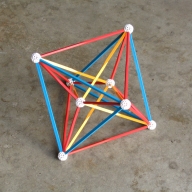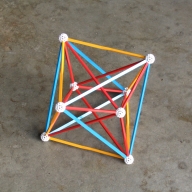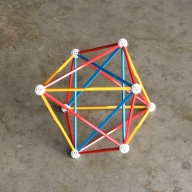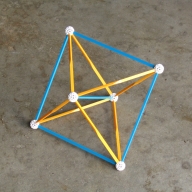The Compound of Fifteen 16-Cells

Introduction
Here is a Zome model of the regular four-dimensional compound of fifteen 16-cells, built during the inaugural "Zomeposium" working conference, held in Chicago, September 24-25, 2005.
Some Mathematical Details
If one is already familiar with the compound of five 24-cells, then it is easy to describe this model: It is its first stellation. In other words, since the first stellation of the 24-cell is a compound of three 16-cells, then the first stellation of the compound of five 24-cells is a compound of fifteen 16-cells. Since the first model has pyritohedral symmetry, the present compound must at least have pyritohedral symmetry. In fact, this model has only pyritohedral symmetry. (If one is not already familiar with the compound of five 24-cells, then one should acquaint oneself with it as soon as possible.)
Recall that there are four "natural" Zome models of the 16-cell {3,3,4}:
|
|
|
|
|
Each of the first three of these models has a trihedral axis of symmetry and the fourth model, requiring only yellow and blue struts, has a 2-fold axis of symmetry passing through a central blue strut. (If this were not a Zome model, this would be a 4-fold axis.) The three models having the trihedral axis provide an instance of the phenomenon of triality. The model has four each of the trihedral type and 3 of the yellow-blue type, making for a total of fifteen. The models must be arranged so that the axes of the 16-cell projections line up with the axes of the pyritohedral group. Notice that this group has 4 axes of trihedral symmetry and 3 axes of 2-fold symmetry.
One can easily check that this compound has precisely 15(8)=120 vertices.
As it turns out, these 120 vertices coincide with those of a regular 600-cell. Let b denote the Golden Ratio and a its field-theoretic
conjugate. The coordinates
of these points in 4-dimensional space, then, are those which can be obtained from
A necessary (but not sufficient) condition that two vectors, say u and v, be connected by an edge of the compound is that they be orthogonal. Said differently, this is a model of fifteen copies of the 4-dimensional "cross polytope", where the centers of all fifteen coincide at the origin in R4
Construction and Destruction of the Model
The model was constructed in several phases, exploiting the pyritohedral symmetry of the model. First, one of us made a single octant:
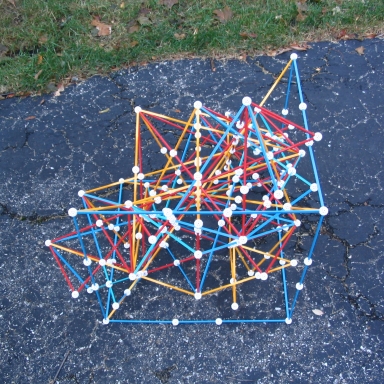
An Octant of the Model
We then built the rest of the model by reflecting the parts across the reflecting planes, first obtaining two octants, then four, and then all eight.

Chris K., DR, and Two Octants
(Photo courtesy of Chris Palmer)

Four Octants
At the end of our meeting, we removed the original octant. The photograph does not show this very well, but we placed a wire rack on the horizontal wall which lied along one of the planes of symmetry:
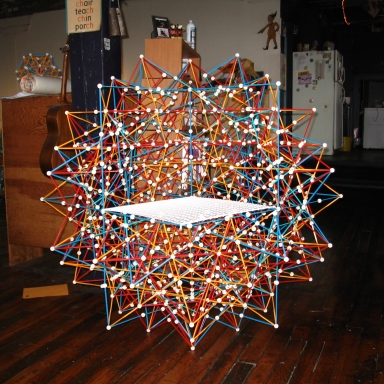
Seven Octants
Ghost Symmetry
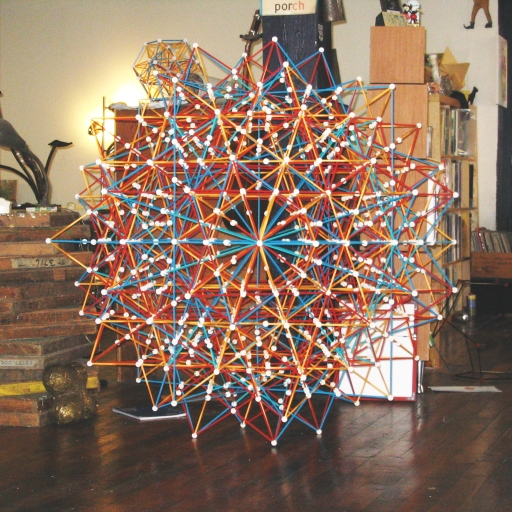
The view along an axis of Ghost Symmetry
One of the startling facts about this model is that, despite the fact that its symmetry group has no elements of order 5 or 10, one may linearly project this model in order to obtain a 2-dimensional figure with 10-fold symmetry. One may see any of these figures by looking down one of the red axes in the Zome System. The presence of this five-fold symmetry is a remnant of the fact that this compound is inscribed in the regular 600-cell.
Parts List
| Part | Quantity |
| Connector | 901 |
| B1 | 24 |
| B2 | 222 |
| B3 | 372 |
| Y1 | 24 |
| Y2 | 216 |
| Y3 | 360 |
| R1 | 120 |
| R2 | 384 |
| R3 | 336 |
Reference.
H. S. M. Coxeter. Regular Polytopes. 3rd ed. Dover Publications Inc., New York, 1973.
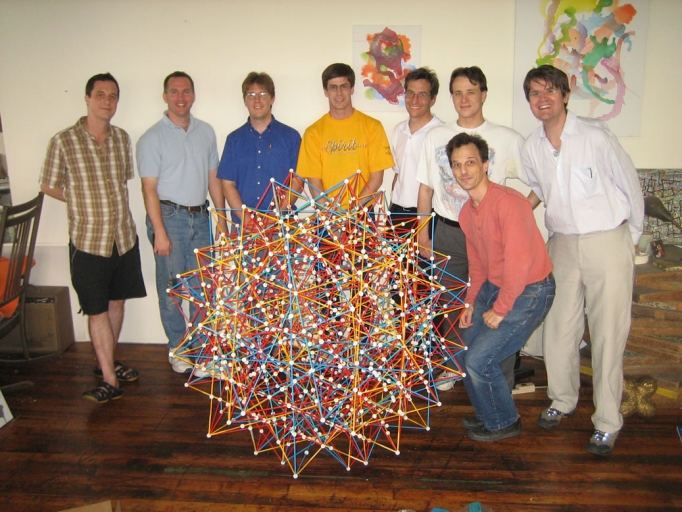
Jerry, Scott, DR, Brian, Paul, John, Chris, and Chris (in front)
(Photo courtesy of Chris Palmer)
